Ke Awa Lau O Puʻuloa
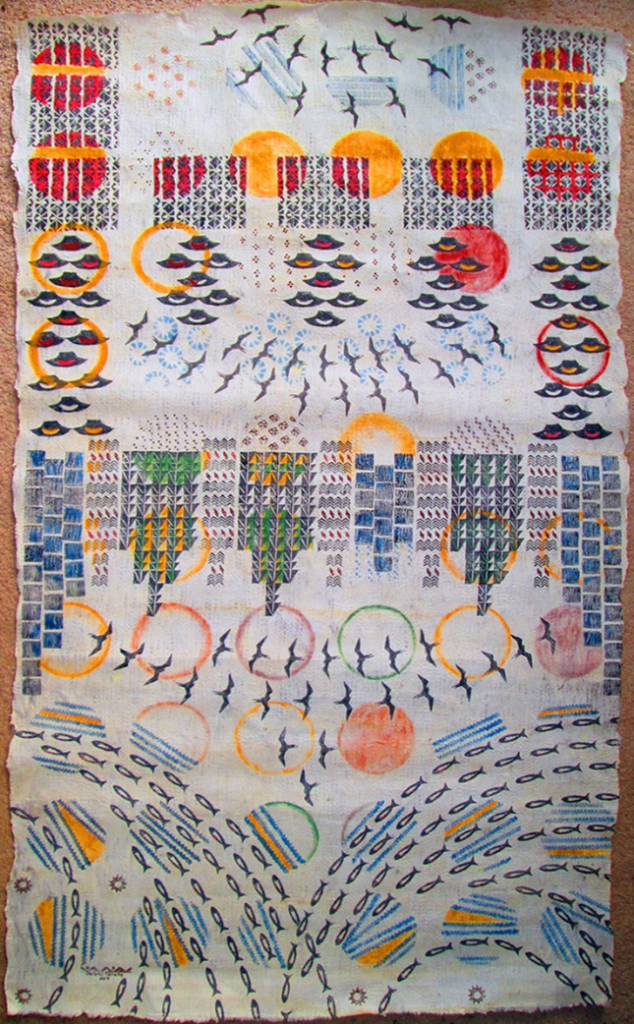
Ke Awa Lau O Puʻuloa (The Many Bays of Puʻuloa)
Hawaiian Kapa; Dalani Tanahy, 2017
“In deciding which motifs to create for this work, I had to decide which of the many stories of Honouliuli to portray, then find and create designs to weave together along with the history, moʻolelo, tales and recollections of the kūpuna. Along with each story/history, I wanted to create a modern moʻolelo; something that was applicable to the place where these images reside, at the University of Hawaiʻi – West Oʻahu, and how they might give meaning to the many students who attend school and strive for higher learning and self-improvement.” – Dalani Tanahy
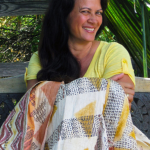 Dalani Tanahy is a master of the traditional art of kapa making. She creates textured fabric from the bark of the wauke or paper mulberry tree in a process perfected over centuries by Native Hawaiian culture makers, which she then decorates with intricate and colorful designs. Her work spans many disciplines, from horticulture to natural dye production, from graphic design to research.
Dalani Tanahy is a master of the traditional art of kapa making. She creates textured fabric from the bark of the wauke or paper mulberry tree in a process perfected over centuries by Native Hawaiian culture makers, which she then decorates with intricate and colorful designs. Her work spans many disciplines, from horticulture to natural dye production, from graphic design to research.
At the Cellular Level
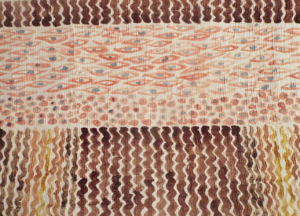 A few years ago, I decided to go back to school. For 20 years I had been a teacher and practitioner of the art of Hawaiian kapa. I realized that while I had an understanding of the art and culture of kapa, what I wanted a greater understanding of, was the science. In a biology class, learning about all the things that create life and keep a body system functioning, I came across a picture of muscle cells. I was immediately struck by ‘kapa-ness’ of the design and I knew that I would decorate a kapa one day with these little muscle cells. As I painstakingly drew each cell, I marveled at past kapa designs and patterns I had seen in museum collections and I began to wonder, “What did our kūpuna really know? What sort of ‘ʻike papalua’, or second sight did they possess that allowed them to create the images and designs that they did…designs that for the most part, we now have limited insight to. In sharing this work with Nāulu Center, I wanted to create a reminder that our kūpuna have always been deeply involved in education, science, math, oration, history, oceanography, astronomy, agriculture, medicine and all branches of human learning and knowledge. The best way to honor them, is to continue down their paths of study and application; to strengthen ourselves so that we may strengthen the systems around us. At the Cellular Level Hawaiian kapa; 12’ x 12” Artist: Dalani Tanahy
A few years ago, I decided to go back to school. For 20 years I had been a teacher and practitioner of the art of Hawaiian kapa. I realized that while I had an understanding of the art and culture of kapa, what I wanted a greater understanding of, was the science. In a biology class, learning about all the things that create life and keep a body system functioning, I came across a picture of muscle cells. I was immediately struck by ‘kapa-ness’ of the design and I knew that I would decorate a kapa one day with these little muscle cells. As I painstakingly drew each cell, I marveled at past kapa designs and patterns I had seen in museum collections and I began to wonder, “What did our kūpuna really know? What sort of ‘ʻike papalua’, or second sight did they possess that allowed them to create the images and designs that they did…designs that for the most part, we now have limited insight to. In sharing this work with Nāulu Center, I wanted to create a reminder that our kūpuna have always been deeply involved in education, science, math, oration, history, oceanography, astronomy, agriculture, medicine and all branches of human learning and knowledge. The best way to honor them, is to continue down their paths of study and application; to strengthen ourselves so that we may strengthen the systems around us. At the Cellular Level Hawaiian kapa; 12’ x 12” Artist: Dalani Tanahy
Makaʻala
 Hawaiian historian and genealogist, Analu K. Josephides shared a moʻolelo passed down to him by his kūpuna regarding some names of the Waimānalo ʻIli in the ahupuaʻa of Honouliuli. The area was referred to as five brothers who protected and cared for the island of O‘ahu; they were the “Eyes” of Oʻahu (CSH, 2008): Their names were Makaīwa, Maka‘ʻke, Makaloa, Makalo, and Makakilo. It was known that Makaīwa was to the farthest west and that Makakilo was to the farthest east. That these five brothers were the eyes of the Oʻahu people and were their protectors. They would watch for enemy intruders and relay messages to their makulu (runners). This is why Oʻahu was a hard island to conquer in the ancient times. By the time the war canoes of the enemies would reach the shores they would be greeted by the warriors of Oʻahu, thus the enemies were never allowed to land upon the shores of Oʻahu. -In the kapa design these watchers are represented by the Great Frigate birds or ʻIwa, as they pass effortlessly over air and sea currents while surveying the vast range of their view-plane, watching over Oʻahu. Makaʻala calls us to a state of alertness, vigilance and being watchful. As citizens of the world, it is wise to watch the things that are happening, whether in history, in the world, on our streets and towns, even in our homes, and be prepared to take action.
Hawaiian historian and genealogist, Analu K. Josephides shared a moʻolelo passed down to him by his kūpuna regarding some names of the Waimānalo ʻIli in the ahupuaʻa of Honouliuli. The area was referred to as five brothers who protected and cared for the island of O‘ahu; they were the “Eyes” of Oʻahu (CSH, 2008): Their names were Makaīwa, Maka‘ʻke, Makaloa, Makalo, and Makakilo. It was known that Makaīwa was to the farthest west and that Makakilo was to the farthest east. That these five brothers were the eyes of the Oʻahu people and were their protectors. They would watch for enemy intruders and relay messages to their makulu (runners). This is why Oʻahu was a hard island to conquer in the ancient times. By the time the war canoes of the enemies would reach the shores they would be greeted by the warriors of Oʻahu, thus the enemies were never allowed to land upon the shores of Oʻahu. -In the kapa design these watchers are represented by the Great Frigate birds or ʻIwa, as they pass effortlessly over air and sea currents while surveying the vast range of their view-plane, watching over Oʻahu. Makaʻala calls us to a state of alertness, vigilance and being watchful. As citizens of the world, it is wise to watch the things that are happening, whether in history, in the world, on our streets and towns, even in our homes, and be prepared to take action.
Waiwai
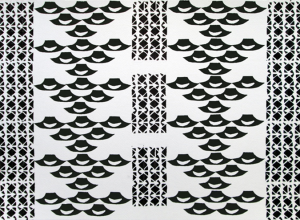 Resort of Gods and Chiefs—It is said that in those days when Kāne and Kanaloa threw stones to mark the boundaries of Honouliuli, they noted that in this place chiefs and commoners mingled freely together. In later times, Kakuhihewa built a heiau in the area and Liholiho travelled through here as well. The shark goddess Kaʻahupāhau guarded the bay and Maui the demi god made a daring rescue of his wife. Pele, Hiʻiaka and Lohiau dramas played out on this side and stories of Kamapuaʻa abound, as it is told that after the death of Chief Olopana, Kamapuaʻa was given all the lands that started with the word ‘wai’. These, he happily accepted, as they were the most fruitful lands, and demonstrated the word ‘waiwai’ which denotes wealth, and in this case, wealth of resources and mana. -This design depicts the standards of the chiefs, their ahuʻula feather capes, and the kiʻi of the gods. Waiwai in old times referred to a wealth of resources, namely water, and then all the things it could grow and supply to sustain life, especially in this dry arid region. Likewise, our own search for wealth lies not only in money and material posses-sions, but all those things that give meaning and abundance to our lives.
Resort of Gods and Chiefs—It is said that in those days when Kāne and Kanaloa threw stones to mark the boundaries of Honouliuli, they noted that in this place chiefs and commoners mingled freely together. In later times, Kakuhihewa built a heiau in the area and Liholiho travelled through here as well. The shark goddess Kaʻahupāhau guarded the bay and Maui the demi god made a daring rescue of his wife. Pele, Hiʻiaka and Lohiau dramas played out on this side and stories of Kamapuaʻa abound, as it is told that after the death of Chief Olopana, Kamapuaʻa was given all the lands that started with the word ‘wai’. These, he happily accepted, as they were the most fruitful lands, and demonstrated the word ‘waiwai’ which denotes wealth, and in this case, wealth of resources and mana. -This design depicts the standards of the chiefs, their ahuʻula feather capes, and the kiʻi of the gods. Waiwai in old times referred to a wealth of resources, namely water, and then all the things it could grow and supply to sustain life, especially in this dry arid region. Likewise, our own search for wealth lies not only in money and material posses-sions, but all those things that give meaning and abundance to our lives.
ʻImi Pono
 The mullet fish of the westside of Oʻahu were so storied that the entire coastline was named for this important resource and called, “ Waiʻanae”. The stories of the exploits of these fish continued from Puʻuloa. Palaʻai was a woman from here who married a Lāʻie man. Homesick, she sent her husband from Lāʻie to fetch mullet from Honouliuli. The mullet followed him as far as Kai-papaʻu and then turned back—as they do today. It was known that the fish would return to certain areas to spawn and then the young fish or ‘ama would swim away to grow up, before re-turning to the marshy protected waters of their birth. -The design depicts the return of the ‘anae to their ancestral home waters. As the young fish grew in protected areas before venturing out into the dangerous seas, so too, the University provides a place to learn and grow as students head out to the great wide world in search of opportunity and further growth. ʻImi Pono reminds us to continue our search for excellence, as the gaining of knowledge and wisdom should be a lifelong journey.
The mullet fish of the westside of Oʻahu were so storied that the entire coastline was named for this important resource and called, “ Waiʻanae”. The stories of the exploits of these fish continued from Puʻuloa. Palaʻai was a woman from here who married a Lāʻie man. Homesick, she sent her husband from Lāʻie to fetch mullet from Honouliuli. The mullet followed him as far as Kai-papaʻu and then turned back—as they do today. It was known that the fish would return to certain areas to spawn and then the young fish or ‘ama would swim away to grow up, before re-turning to the marshy protected waters of their birth. -The design depicts the return of the ‘anae to their ancestral home waters. As the young fish grew in protected areas before venturing out into the dangerous seas, so too, the University provides a place to learn and grow as students head out to the great wide world in search of opportunity and further growth. ʻImi Pono reminds us to continue our search for excellence, as the gaining of knowledge and wisdom should be a lifelong journey.
Hoʻoulu
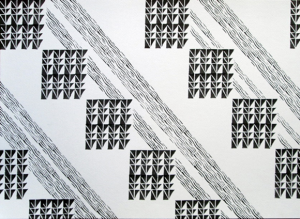 It is believed that a large native population was sustained in the ahupuaʻa of Honouliuli. Stretching from the dry coastal areas where fishing and ground nesting birds were plentiful, to the area now known as West Loch, where there was an abundance of shellfish, crustaceans and areas suitable to build fish ponds. Lands well irrigated with fresh water springs created perfect conditions for loʻi kalo cultivation. Dry lowland forests would have provided hardwood resources. The design depicts the freshwater springs and streams that nourished a community by feeding and maintaining the health of the kalo. Hoʻoulu denotes growth, such as that of a seed or plant, but it also means ‘to stir up or rouse to action’, and further, ‘to inspire with courage or hope. The things that mattered most to our kūpuna included hard-working hands, attentive and thoughtful minds, and the gracious sharing of aloha. It is hoped that time spent at the University of Hawaii–West Oʻahu will instill these and many other attributes that will ground, and then send forth, haumāna who are prepared to challenge and embrace an ever-changing world.
It is believed that a large native population was sustained in the ahupuaʻa of Honouliuli. Stretching from the dry coastal areas where fishing and ground nesting birds were plentiful, to the area now known as West Loch, where there was an abundance of shellfish, crustaceans and areas suitable to build fish ponds. Lands well irrigated with fresh water springs created perfect conditions for loʻi kalo cultivation. Dry lowland forests would have provided hardwood resources. The design depicts the freshwater springs and streams that nourished a community by feeding and maintaining the health of the kalo. Hoʻoulu denotes growth, such as that of a seed or plant, but it also means ‘to stir up or rouse to action’, and further, ‘to inspire with courage or hope. The things that mattered most to our kūpuna included hard-working hands, attentive and thoughtful minds, and the gracious sharing of aloha. It is hoped that time spent at the University of Hawaii–West Oʻahu will instill these and many other attributes that will ground, and then send forth, haumāna who are prepared to challenge and embrace an ever-changing world.